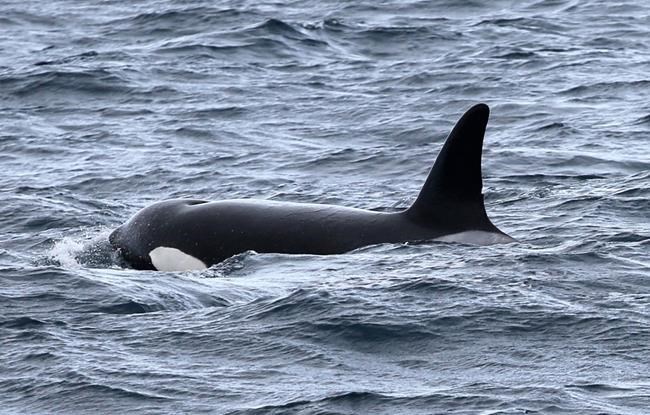VANCOUVER — Researchers from the University of British Columbia said they've identified a potentially new population of open-ocean orcas, which hunt the biggest predators on the planet.
In a study published Friday, researchers said a group of 49 orcas has been observed hunting sperm whales off the coast of California and Oregon.
Lead author Josh McInnes said the orcas were seen hunting a herd of nine adult sperm whales, "eventually making off with one."
It's the first time killer whales have been reported attacking sperm whales on the West Coast, he said.
“Other encounters include an attack on a Pygmy sperm whale, predation on a northern elephant seal and Risso’s dolphin, and what appeared to be a post-meal lull after scavenging a leatherback turtle,” said McInnes, who is a masters student in the UBC Institute for the Oceans and Fisheries.
Researchers said the orcas that were observed in nine encounters from 1997 to 2021 could either belong to a subpopulation of transient killer whales or a unique oceanic population.
The study said the encounter that was witnessed with the sperm whales occurred in 1997 about 130 kilometres off the California coast. Many of the sperm whales in the pod were left with “extensive injuries," while one was killed, the study said.
“Approximately 12 killer whales were initially involved in the hunt, but this number increased to an estimated 35 killer whales spread out over 3 km. Small concentrated groups of four to five killer whales randomly targeted and attacked individual sperm whales in the rosette,” the study said, describing how the whales gathered in a circle with their heads together and their tails pointing outward.
“Fresh blood and an oil slick of animal fat could be seen at the surface following each attack,” the study continued.
It said one of the whales was dragged away from the rosette with several orcas seen feeding on it.
In another encounter that took place in 2001 about 350 kilometres off the California coast, seven killer whales from the same group were observed scavenging from a leatherback turtle.
McInnes said scientists collected a lot of photographs and data through these encounters, but they couldn’t match or recognize any of the orcas to other known killer whales in the northeastern Pacific.
He notes there are three different types of killer whales that live along the coast of California and Oregon: residents, transients, and offshores.
The study said the individuals they encountered shared physical similarities with both transient and offshore ecotypes, but were not “a perfect fit” with either.
The report said researchers were able to identify the orcas as possibly a new group partially because of bite scars on their bodies from the cookiecutter shark, a species of parasitic sharks that lives in the deep ocean.
“The presence of cookiecutter shark wounds provides indirect evidence that these unknown killer whales had spent time in warmer oceanic waters,” said the study.
McInnes said almost all of the orcas had the scars, while they haven't seen them on other killer whales.
“But the big question is, where do these killer whales kind of fit in? We don't know ... but what we do know is that they represent a population that seems to spend more time in the open ocean,” McInnes said in an interview.
Co-author Andrew Trites from the UBC Institute for the Oceans and Fisheries said it's "pretty unique" to find a new population of killer whales given the time needed to gather photos and recognize the animals as different than known populations.
Researchers said they also observed physical differences in the killer whales such as patches on their fins and saddle.
They said they hope to document more sightings and data from the new population in order to investigate exactly how different these orcas are from other documented populations.
McInnes said the discovery is the first part of a fun puzzle that they are working on.
“We're just kind of at the tip of the iceberg of what these whales are doing. I mean, are they all one population? Are they multiple? We don't know. So, I feel like this is kind of the big start of the next steps in our research, and to maybe get more sightings and more information," said McInnes.
This report by The Canadian Press was first published March 15, 2024.
Nono Shen, The Canadian Press




